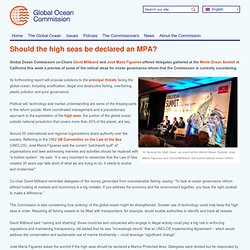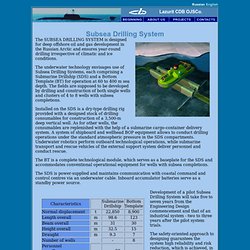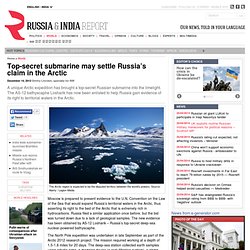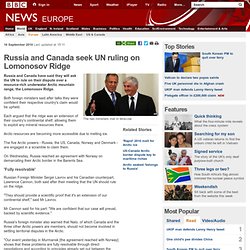

Should the high seas be declared an MPA? Global Ocean Commission co-Chairs David Miliband and José María Figueres offered delegates gathered at the World Ocean Summit in California this week a preview of some of the radical ideas for ocean governance reform that the Commission is currently considering.

‘In Taming the High Seas’, an event at the World Ocean Summit, José María Figueres and David Miliband, discussed radical ocean reform Its forthcoming report will propose solutions to the principal threats facing the global ocean, including acidification, illegal and destructive fishing, overfishing, plastic pollution and poor governance. Lazurit CDB OJSCo. - Subsea Drilling System. The SUBSEA DRILLING SYSTEM is designed for deep offshore oil and gas development in the Russian Arctic and ensures year-round drilling irrespective of climatic and ice conditions.

The underwater technology envisages use of Subsea Drilling Systems, each comprising a Submarine Drillship (SDS) and a Bottom Template (BT) for operation at 60 to 400 m sea depth. The fields are supposed to be developed by drilling and construction of both single wells and clusters of 4 to 8 wells with subsea completions. Installed on the SDS is a dry-type drilling rig provided with a designed stock of drilling consumables for construction of a 3,500-m deep vertical well. Top-secret submarine may settle Russia’s claim in the Arctic. Moscow is prepared to present evidence to the U.N.

Convention on the Law of the Sea that would expand Russia’s territorial waters in the Arctic, thus asserting its right to the bed of the Arctic that is extremely rich in hydrocarbons. Russia filed a similar application once before, but the bid was turned down due to a lack of geological samples. The new evidence has been obtained by AS-12 Losharik – Russia’s top-secret deep-sea nuclear-powered bathyscaphe. The North Pole expedition was undertaken in late September as part of the Arctic 2012 research project.
The mission required working at a depth of 1.5-1.8 miles for 20 days. Losharik will very soon be getting a younger “sister.” Until recently, the competing territorial claims to the Arctic made by Russia, Norway, Canada, the U.S. and Denmark have been ineffectual, since, apart from political statements, none of the countries has been able to provide any factual evidence to justify their claims. Russia and Canada seek UN ruling on Lomonosov Ridge. 16 September 2010Last updated at 15:11 The two ministers met in Moscow Russia and Canada have said they will ask the UN to rule on their dispute over a resource-rich underwater Arctic mountain range, the Lomonosov Ridge.

Both foreign ministers said after talks they were confident their respective country's claim would be upheld. Each argued that the ridge was an extension of their country's continental shelf, allowing them to exploit any mineral resources there. Arctic resources are becoming more accessible due to melting ice. The five Arctic powers - Russia, the US, Canada, Norway and Denmark - are engaged in a scramble to claim them. China's surveys in Okinawa Trough raises alarm in Japan. China plans two geological surveys in the East China Sea this year, which could heighten tensions with Japan over the exploitation of undersea resources.

China proposed the surveys in the Okinawa Trough in June and July for scientific research, which is approved under the U.N. Convention on the Law of the Sea, according to sources. Japan agreed on condition that China will not conduct exploration for mineral resources. The first survey is planned between Sept. 1 and Nov. 30, and the second on Dec. 31. Japan activists land on disputed islands amid China row. 19 August 2012Last updated at 08:16 GMT The Japanese activists raised their country's flag after they landed At least 10 Japanese nationalist activists have landed on a group of disputed islands, amid an escalating territorial row with China.

The activists swam ashore after a flotilla carrying about 150 people reached the Japanese-controlled Senkaku islands, called Diaoyu in China. Japan's coast guard is now questioning the activists, who had earlier been denied permission to visit the islands. The move triggered protests in China and strong condemnation from Beijing. Japan activists land on disputed islands amid China row. SHEDDING SOME LIGHT ON THE INTERNATIONAL SEABED AUTHORITY. In my previous post, I outlined some of the possible impacts of mining at deep-sea vents on marine life, and how effective regulation at a regional scale will be essential to reduce risks of habitat loss and potential species extinction.

So for a second post to accompany Week 6 of our “Massive Open Online Course” on “Exploring our oceans”, let’s now take a look at the regulator that already exists for seafloor mining in international waters: the United Nations International Seabed Authority (ISA). As we shall see, its procedures perhaps deserve some scrutiny and constructive critique, given their responsibility for environmental protection of the deep-sea floor. How the ISA works First of all, we should note that the International Seabed Authority exists to administer seafloor mining in international waters; it does not actually have a mandate to consider whether seafloor mining per se is desirable or not.
UK_EEZ.png (PNG Image, 600 × 261 pixels) ISA_SMS.jpg (JPEG Image, 1772 × 1101 pixels) - Scaled (63%) International Seabed Authority.